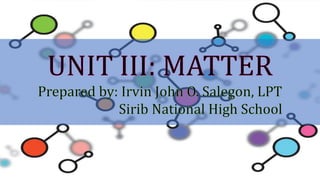
Unit 3 Matter
- 2. Choose the best answer and write the letter of your choice on the space provided before each number.
- 3. _____1. Which of the following is an of matter? A. fire C. heat B. sound D. energy
- 4. _____2. Of the phases of matter, which has the strongest attractive forces? A. Solid C. Gas B. Liquid D. all of the above
- 5. _____3. Which of the characteristics of makes it an roofing material?
- 6. A. It is shiny. B. It has high density. C. It can be hammered into sheets. D. It can be drawn into fine wire.
- 7. _____4. Which of the following best describes the components of seawater (mixture)?
- 8. A.They are chemically combined. B.They have no definite proportion. C.They combine in a fixed ratio by mass. D.They cannot be separated by physical means.
- 9. _____5. Gold is to element while _____ is to compound. A. ethanol C. aluminum B. rubbing alcohol D. muriatic acid
- 10. _____6. Which does not belong to the group? A.table salt B.mayonnaise C.salt solution D.halu-halo
- 11. _____7. Using the table below, which material do you expect to sink in water? Material Density (g/mL) Aluminum 2.7 Ice 0.92 Iron 7.8 Mercury 13.6
- 13. _____8. Which is a chemical change? A.boiling water B.souring of milk C.chopping of wood D.melting of ice cream
- 14. _____9. i. Rusting of iron is a chemical change. ii. All phase changes are physical changes.
- 15. A.Both are true. B.Both are false. C.The first statement is true while the second is false. D.The second statement is true while the first is false.
- 16. _____10. Jeff placed some mothballs inside the cabinet. After some days, the mothballs disappeared. What happened to the mothballs?
- 17. A.It sublimed. B.It evaporated. C.It reacted with air inside the cabinet. D.It was dissolved by water present in air.
- 26. Follow Up Activity: Things Around Me
- 31. Properties depend on size
- 32. Properties do not depend on size
- 33. A chemical property is
- 34. 1. All matter have ______ and will occupy ________. 2. Matter is made up of __________. 3. Between these particles are ___________.
- 36. Studying about what matter is made of involves dealing with very small “particles” beyond what your eyes can see.
- 37. The atomic model has changed throughout the centuries, starting in 400 BC, when it looked like a billiard ball.
- 38. Almost 2,500 years ago, Greek philosophers, Leucippus and his disciple, Democritus believed that nature consisted of two things, “atoms and the void that surrounds them” (Knieram, 1995-2013). They believed that “atoms are physically, but not geometrically, indivisible.”
- 39. He named the smallest piece of matter “atomos,” meaning “not to be cut.”
- 40. To DEMOCRITUS •Atoms were small, hard particles that were all made of the same material but were different shapes and sizes. •Atoms were infinite in number, always moving and capable of joining together.
- 41. This theory was ignored and forgotten for more than 2000 years!
- 42. •The eminent philosophers of the time, Aristotle and Plato, had a more respected, (and ultimately wrong) theory.
- 44. •In the early 1800s, the English Chemist John Dalton performed a number of experiments that eventually led to the acceptance of the idea of atoms.
- 45. •All elements are composed of atoms. Atoms are indivisible and indestructible particles. •Atoms of the same element are exactly alike. •Atoms of different elements are different. •Compounds are formed by the joining of atoms of two or more elements. Dalton’s Theory
- 46. Today, we know that although atoms are very small, they are not indivisible as Democritus thought, rather they consist of still smaller particles, Democritus was right in one aspect of his belief, that is, atoms are the smallest particles of which substances are made.
- 47. Atoms of most elements have the ability to combine with other atoms. When two or more atoms are combined together in a specific arrangement, a molecule is formed.
- 49. The size of an atom is measured in angstroms. One angstrom is a unit of length equal to one ten millionth of a millimetre.
- 50. The scanning tunneling microscope (STM) allows scientists to view and scan the surface of very small particles like atoms.
- 53. 1. Oil 6.Wind 2.Hollow Block 7.Ink 3.Electricity 8.Books 4.Crayola 9.Sound 5.Fart 10. Vapor
- 54. 11. It is a characteristic that can be observed without changing or trying to change the substance.
- 55. 12. It a characteristic that cannot be observed without changing a substance.
- 56. 13-15. Complete the statement below. ________ is anything that occupies _____ and has _____.
